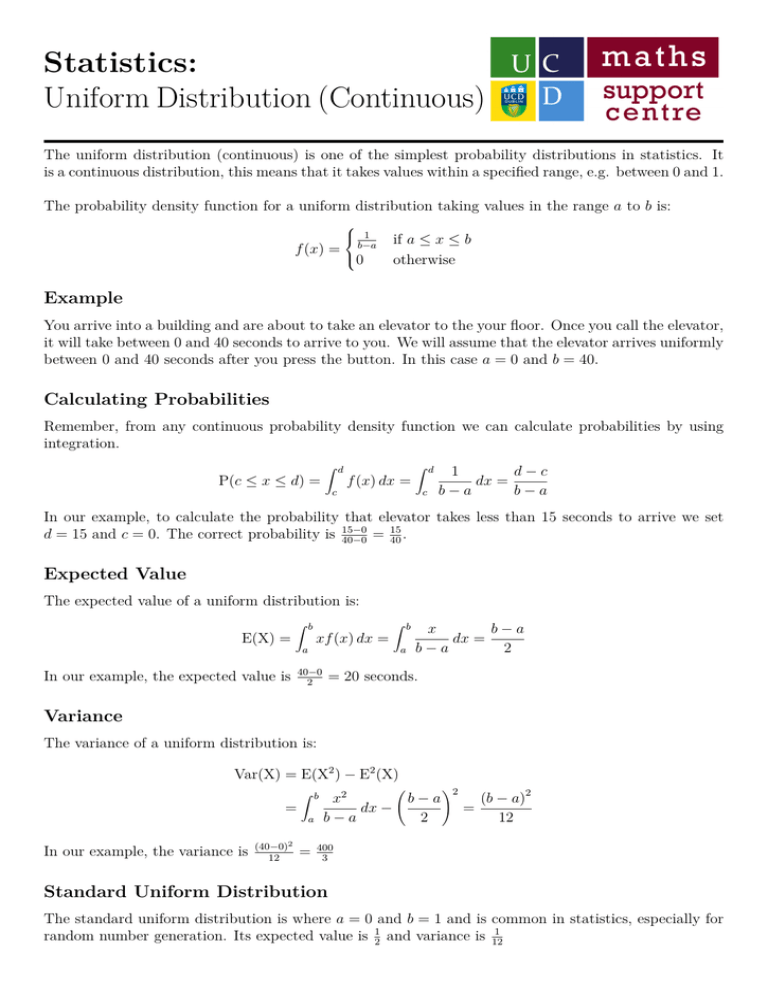Statistics: Uniform Distribution (Continuous)
advertisement

Statistics: Uniform Distribution (Continuous) The uniform distribution (continuous) is one of the simplest probability distributions in statistics. It is a continuous distribution, this means that it takes values within a specified range, e.g. between 0 and 1. The probability density function for a uniform distribution taking values in the range a to b is: f (x) = 1 b−a 0 if a ≤ x ≤ b otherwise Example You arrive into a building and are about to take an elevator to the your floor. Once you call the elevator, it will take between 0 and 40 seconds to arrive to you. We will assume that the elevator arrives uniformly between 0 and 40 seconds after you press the button. In this case a = 0 and b = 40. Calculating Probabilities Remember, from any continuous probability density function we can calculate probabilities by using integration. P(c ≤ x ≤ d) = Z d f (x) dx = Z d c c 1 d−c dx = b−a b−a In our example, to calculate the probability that elevator takes less than 15 seconds to arrive we set = 15 . d = 15 and c = 0. The correct probability is 15−0 40−0 40 Expected Value The expected value of a uniform distribution is: E(X) = Z b xf (x) dx = Z b a In our example, the expected value is a 40−0 2 x b−a dx = b−a 2 = 20 seconds. Variance The variance of a uniform distribution is: Var(X) = E(X2 ) − E2 (X) = Z b a In our example, the variance is (40−0)2 12 = x2 b−a dx − b−a 2 !2 (b − a)2 = 12 400 3 Standard Uniform Distribution The standard uniform distribution is where a = 0 and b = 1 and is common in statistics, especially for 1 random number generation. Its expected value is 21 and variance is 12 Statistics: Uniform Distribution (Discrete) The uniform distribution (discrete) is one of the simplest probability distributions in statistics. It is a discrete distribution, this means that it takes a finite set of possible, e.g. 1, 2, 3, 4, 5 and 6. The probability mass function for a uniform distribution taking one of n possible values from the set A = (x1 , .., xn ) is: f (x) = 1 if x ∈ A otherwise n 0 Example DICE?? Calculating Probabilities Remember, from any discrete probability mass function we can calculate probabilities by using a summation. d X P(xc ≤ X ≤ xd ) = f (xi ) = d X i=c i=c 1 n In our example, to calculate the probability that the dice lands on 2 or 3 we set d = 3 and c = 2. The correct probability is 61 + 16 = 62 . Expected Value The expected value of a uniform distribution is: E(X) = n X xi f (xi ) = i=1 In our example, the expected value is n X xi i=1 1+2+3+4+5+6 6 n = Pn = 1+6 2 i=1 xi n = x1 + x n 2 = 3.5. Variance The variance of a uniform distribution is: (b − a + 1)2 − 1 Var(X) = 12 In our example, the variance is (6−1+1)2 −1 12 = 35 12 = 2.9 Standard Uniform Distribution The standard uniform distribution is where a = 0 and b = 1 and is common in statistics, especially for 1 random number generation. Its expected value is 21 and variance is 12




